I’ve lately received more information on these – *ahem*- unique instruments from owner Dave Usher and his mother, Alex, along with Darcy Kuronen (who featured their instrument in the BMFA’s Dangerous Curves exhibition and book.
The first topic at hand here is the “Harmony” provenance – what do we actually know?
Assuming the reader is thoroughly familiar with my initial blog on Paul Gardie and the surviving “Orchestral Harp Guitars,” remember that nothing on the 1916 Gardie patent points to the Harmony company. Yet vintage guitar lore points to Harmony as the maker, and there are many clues that back this up.
One clue that we finally got to the bottom of is the “stamp”: Darcy’s notes for the exhibit specifically state that the neck block is stamped Harmony, yet the current owner Dave Usher originally couldn’t find any such stamp. And then shortly after I first posted this, he did! It turned out to be on the tail block of the bass side. So Darcy was correct. Dave cannot get an image of it, but describes it as “a faint stamp in black ink and small text as follows: The Harmony Co. Chicago, Il.”
For more on the Harmony story, we turn to Stew Hart, who has long owned another of these, handed down through the family. Darcy recently spoke to him again on our behalf, learning that the instrument is in storage with a sister, so it may be some time before someone is able to poke around in it.
Stew, it turns out, has the “inside information” about the Harmony connection. Darcy’s notes state that “the instrument came down through his family, and was supposedly made (along with “7 others!”) by a relative named Schultz, who was a stepfather to this fellow’s aunt. Schultz was reportedly the foreman (?) at the Harmony guitar shop.”
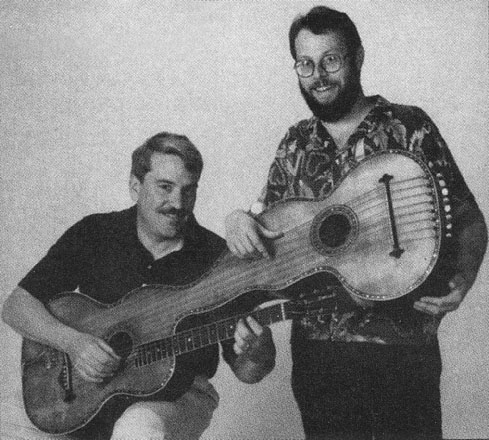
Darcy also pointed me to an entry in the Sept 1986 Guitar Player, which included this image of Stew and his guitar. Plucking the bass strings is luthier Dana Bourgeois, who snapped the picture after doing some work on the instrument (25 years later, Dana says that he kept no photos or notes on the project).
The photo caption explains that it was “made by William J. F. Schultz, founder of the Harmony company.” That information undoubtedly came from Stew’s family lore.
So what of Schultz? True – according to Tom Wheeler’s book American Guitars: an Illustrated History, Schultz founded Harmony in1892. Though Sears bought the company in 1916, Schultz remained its president until 1926. The GP blurb (via Stew) guesses “the ’20s” for the date of the guitar – not too far off, as it/they were certainly made around 1915-1916, around the patent period. My guess is that Harmony founder/president Schultz could have remained “foreman” of the Harmony custom shop area, and had a direct hand in the creation, even if leaving the actual building to others.
How many were made? Surviving specimens remain rumored at 3-4 at best. The number “7 others” (meaning 8 total) – a verbal hand-me-down count through the family remains hearsay but is not impossible.
A last, interesting comment in the GP caption is that the harp guitar “can be played by one or two people” as demonstrated by Stew and Dana (!). My bet is that they weren’t joking, as the thing does indeed look like a giant “courting dulcimer” – as if the boy played the neck while his date played the subs (or vice versa). Of course, we know that this wasn’t the plan, and inventor Paul Gardie imagined it as a serious solo instrument.
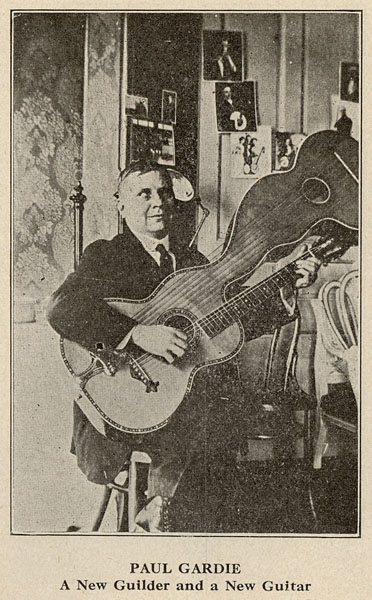
Bottom line on provenance: We can finally say that these instruments were indeed made in the Harmony factory, probably in the custom shop, either built by founder Schultz or overseen by him.
Meanwhile, another mystery remained, and that was the hidden hollow neck of the invention. Apparently, none of the owners nor Darcy had ever spotted it, and wouldn’t have even thought to look, as the patent was unknown to all until recently. Though the patent shows a second continuous airway between the bodies via the neck (!), it does not seem to go all the way through.
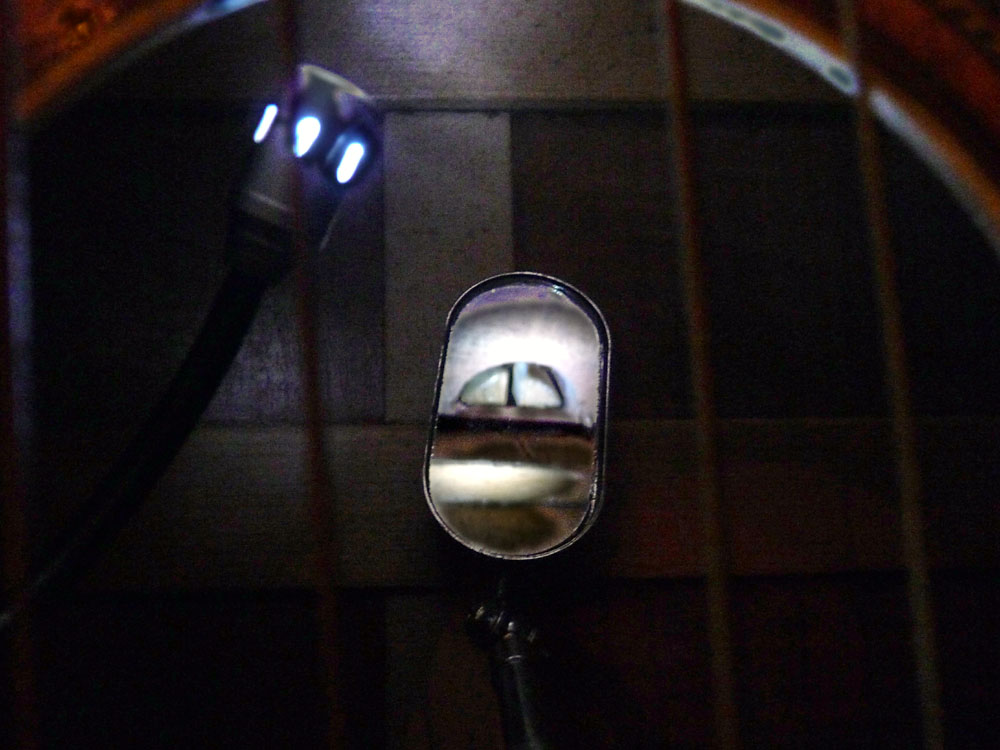
Dave Usher kindly offered to investigate with a dental mirror and camera – and initially thought, there it was! He explains:
I looked around in there and see the following. It’s definitely a weird guitar (of course, we already knew that)! I used to do a lot of musical instrument repair back in the ’70s and know one or two things about this stuff.
1. It appears that the neck and neck end block might be one piece, the rest of the body built onto the neck block/neck. However, since I don’t see end grain facing me at the end block that is probably not the case. It could be that the neck block has a nose that is inserted into the neck. There is a hole in the neck block that looks like a traditional cartoon floorboard mouse hole, perhaps 1” wide and nearly as tall. There is a little 1/8” dia pin just inside the hole, and perhaps a couple of shims. The pin comes into the hole from the back side of the instrument and does not extend all the way thru the hole. This suggests that the neck block inserts into the neck and is pinned from the back? I can’t say how far the hole goes up the neck, but I can’t see very far into it with my little inspection mirror.
2. The neck block extends (in one piece) downwards and ends shortly after the beginning of the lower body curve (which would be the lower part of the instrument if you were holding it).
3. The neck block extends upwards and ends shortly after the curve heading into the upper body extension. So, there is a large attachment area bonding the neck block to the body.
4. I did not see any markings or stamps indicating “Harmony” or any other manufacturer (I cannot see much of anything between the top bracing tho).
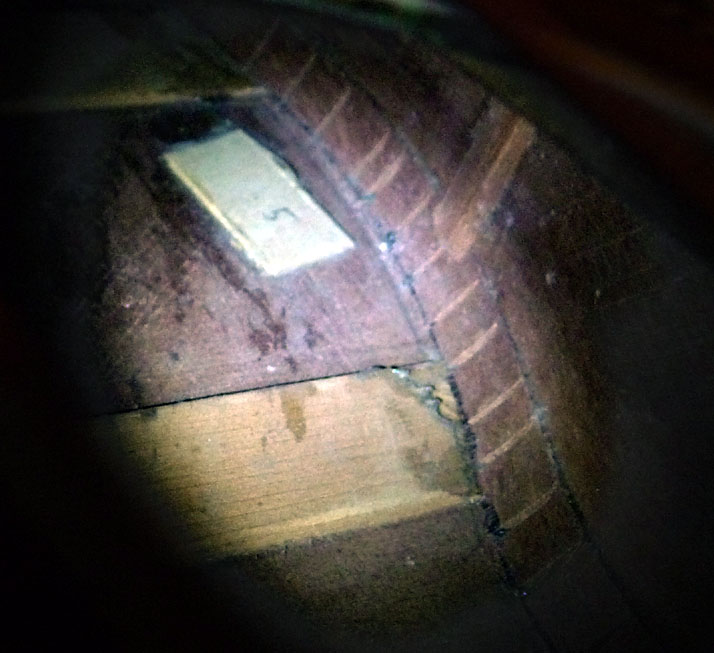
5. On the inside of the back there are several small thin wood pieces like one would use to repair a crack. They are distributed at uneven intervals and orientations around the perimeter of the back and perhaps 2” in from the sides of the instrument. They are numbered. But they are not oriented perpendicular to the grain, so I don’t think they were put there as a repair. The numbers appear to have been written in blue ballpoint pen so I don’t think they were original.
6. I did look at the soundboard bracing. I’m not an expert at guitar bracing, but it sure looks pretty wild to me.
7. The perimeter of the body is bonded to the top and back with serrated wood blocks. It is a very light eggshell construction. I do not see any heavy-duty bracing in there.
8. The top is one-piece spruce construction. This blows people away. The back is also one piece – it appears to be mahogany?
9. The sides are two pieces joined at each tail block. At one time the curved area at the top of the instrument near the bass end was damaged and a 4” x 3” portion of the side replaced. Looks like she got dropped once – not bad for an instrument of this age.
I wish I had one of those inspection video cams. It would need about 4’ of extension and be steerable to get into the other end of the instrument. It would be a trip to take a tour of the inside of this thing. If you can borrow one and send it to me I’ll be happy to shoot it.
Great analysis, Dave – especially the “traditional cartoon floorboard mouse hole”!
Unfortunately, after poking around in there some more, Dave does not think the hole goes through the neck at all. He explains:
I took another look at the mouse hole and did some jockeying to get a better view. I need to revise the description. What I thought was a pin is actually glue.

It does not appear that the hole goes back into the neck. It appears to be a domed cut-out. There is a fair amount of glue in there complicating things (the glue appears to be original – I do not see signs of rework). Since I can’t get a good shot of it given my equipment, here is a drawing of what it appears to be. The flat side towards the bottom of the drawing is facing the fingerboard. It could be that the quarter-round extends into the neck, but I cannot tell.
So, if the neck is hollow, it is internal and cannot be seen short of removing the fingerboard. It is not a thick neck, so my guess is that it could not be hollowed out without significantly weakening the neck.

Additionally, Dave has started to use the instrument, sending this live recording of No Place Like Home, accompanying his mother Alex (playing Autoharp) on it – with subs down to a low C! (Dave Powell, eat your heart out)
Alex kindly pointed me to a couple of old family photos of her with the instrument, which she describes with obvious love as the “Straddlevarious” or “Goitar.” These are in her songbooks, Children’s Song Favorites and Side Splitters.
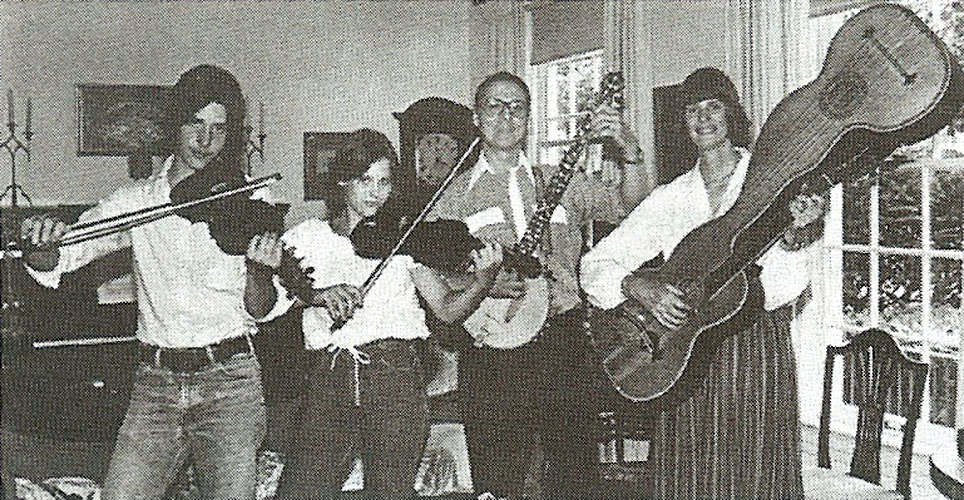
Alex (right) and family (sans Dave, who was away at college)
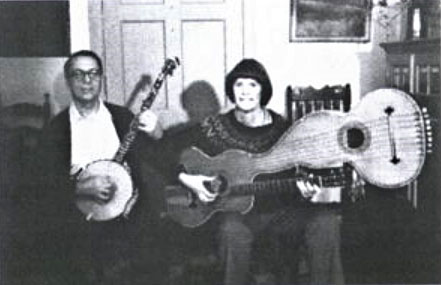
Alex with her husband
Alex also described another specimen she once ran across:
When I was in Chicago a number of years ago I dropped into a music store that was in a high-rise building there. When I showed the owner a picture of the “goitar” he said he had one in the back storeroom that was in pieces. Mine was originally owned by a man named Campbell who worked for the “Great Northern Railroad” promoting trips to the West.
So that now brings us up to date with the infamous Gardie/Harmony harp guitars…
Oh, and I found that great newspaper photo of SB at Winfield playing Dave Usher’s instrument. I love this photo! – the madcap wizard-of-harp guitar with the impossible instrument.
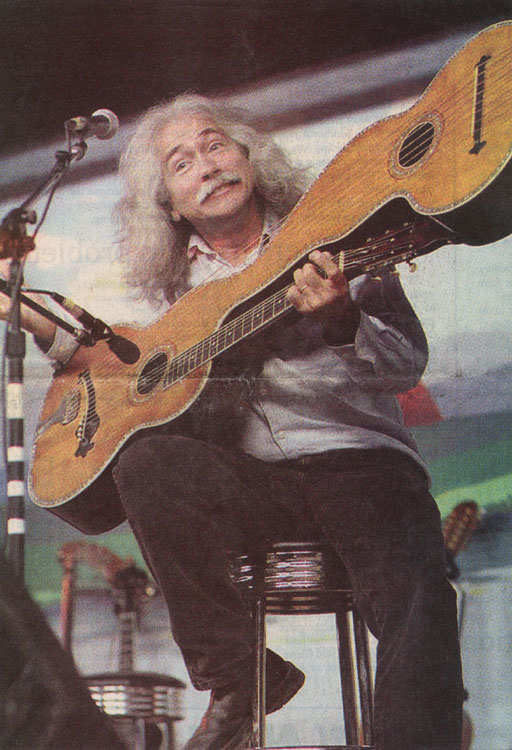

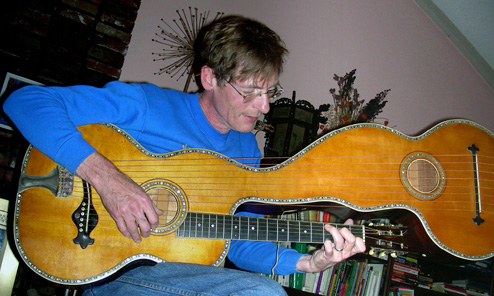
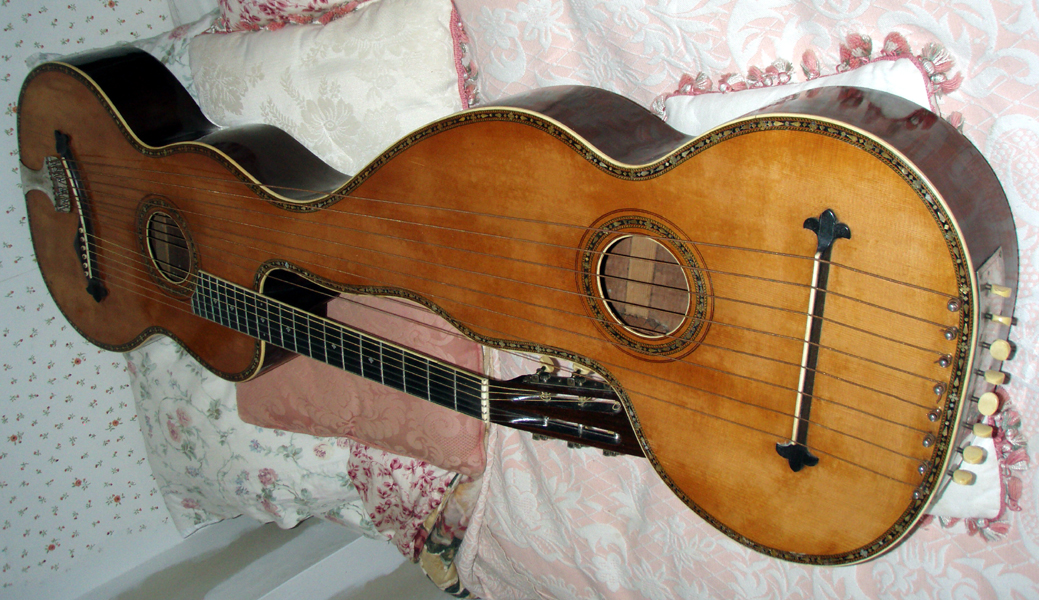
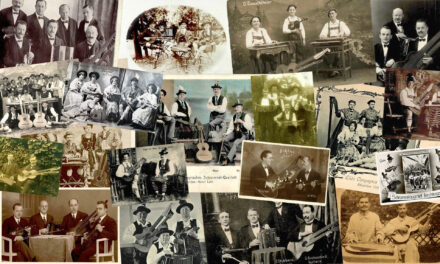
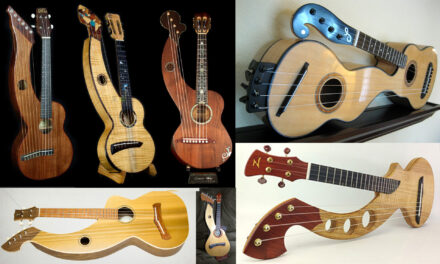
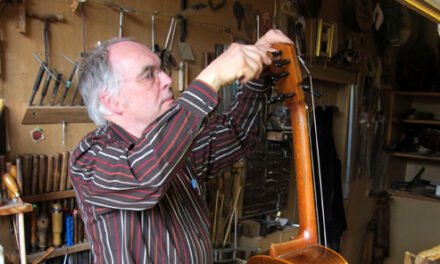
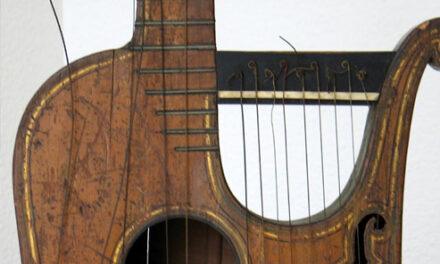
Not that this is world shatteringly important information, but Steve Howe was in Yes, not the Who. Thanks so much for the wonderful and informative background on this wild instrument.
I put a video of this guitar being played on Facebook. see https://www.facebook.com/video.php?v=804674292904219
We played “No Place Like Home” Recorded at the Folk School in Maplewood, Mo.on Aug 7, 2010.
My mother, Alexandra M. Usher is playing one of the first Zimmerman autoharps sold in the U.S. in the early 1880’s.
What a nice article! Thanks for giving me a lot of information I didn’t know before about the Straddlevarious. I’m not sure I told you how I happened to become its owner.
Many years ago (in the 1960’s perhaps) I got a telephone call from a lady at our church who knew I was a folk singer. She said that she and her husband were leaving town to retire in Wisconsin and she had a guitar that had been given to her by a Chicago man named Campbell who had worked earlier in the century for the railroads encouraging people to tour the great Northwest by rail. He would give programs singing with the guitar. He used it to sing to groups of children in summer camps in Michigan, too. She started to describe the guitar on the telephone and I thought maybe she had downed one drink too many. She said she would like me to have it if I was interested. I went over and took a look and, gee whiz, it was just as she described. It was in its custom case which has just as many outrageous curves as the guitar itself. Of course I took it off her hands. I told her I couldn’t afford to pay her what it was worth …. that I could only pay $300 for it, which, thank heavens, she accepted. Soon after we had an unveiling at a folksingers’ party at our house and various people offered monikers for her; The Goitar, the Push-me-pull you, and the Two-Seater. When Darcy Kuronen borrowed her for the Boston Museum show he was kind enough to have bass strings custom-made, and Steve How of the Who had a good time trying it out. There was also a track of someone playing it on the exhibit recording.